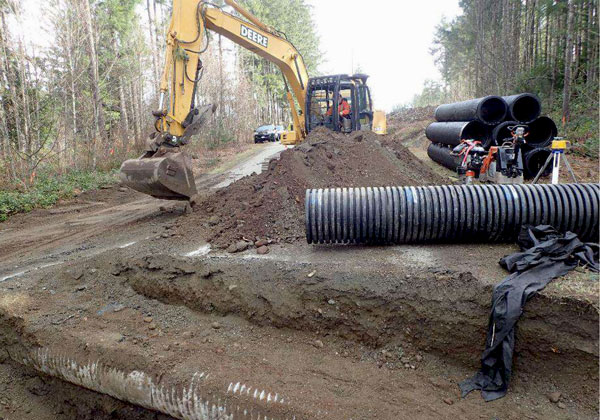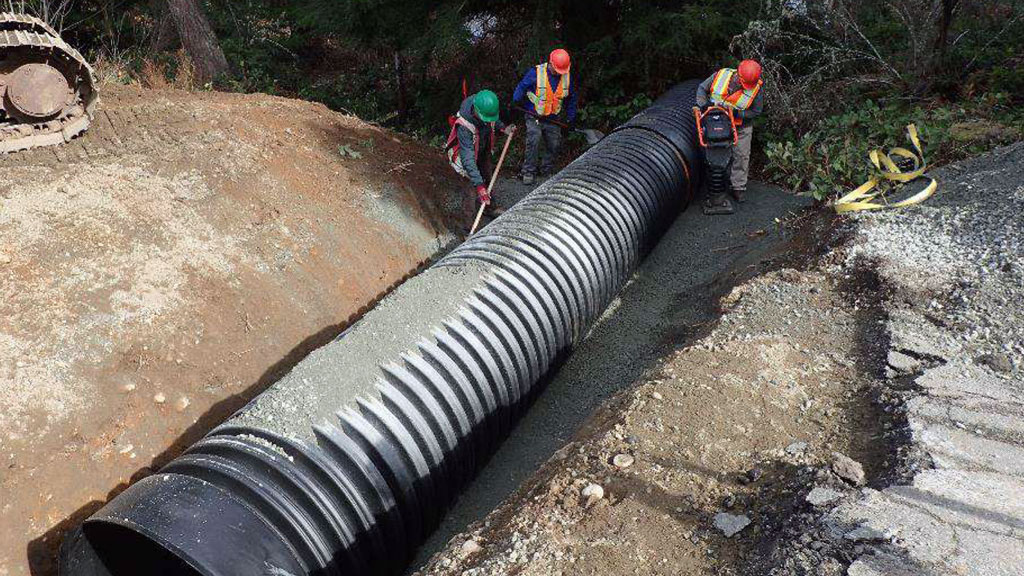Construction workers have come to the rescue of tens of thousands of migrating western toads who must cross a road near Duncan, B.C. on Vancouver Island each year to make it to their breeding grounds.
Four plastic underground tunnels were recently installed in a 700-metre corridor along Riverbottom and Barnjum roads to allow the toads and other small amphibious critters to cross the thoroughfares unharmed.
In essence, the toads now have an underground highway of their own that will allow them safe passage from the forest area to Wake Lake.
“It’s quite a wide migration corridor,” says Sean Wong, senior biologist with the B.C. Ministry of Transportation and Infrastructure (MTI) in Victoria, who was field site supervisor for the project. “They go to breed in the lake and when they out-migrate they can go in all directions.
“We focused on the hot spots based on previous assessments which showed where the higher migration areas were. By focusing on those hot spots we hope to capture some of the bigger migration routes.”
Western toads have been federally listed as a special concern by the Committee on the Status of Endangered Wildlife in Canada. They are a native species that are important to the local ecosystem. In spring, adults go to the lake to breed and then return to the forests. The juvenile toads join them in the return journey.
However, many of the toads are struck by cars as they hop across the road on their annual pilgrimage. The ministry decided to step in and create the tunnel and a fence system to direct them under the roads instead.
“The critters migrate, and they were getting run over,” explains Wong. “To help them get across, we put in culverts and directive fencing to help guide them. This angled fencing ideally helps direct them into the culverts.”

Two excavators were brought in to prepare the embankments and areas for installation of the culverts and fencing. Crews spent roughly three weeks grading the embankments. They had to break up asphalt on the road and dig trenches for the culverts. Crews spent two days laying the culverts themselves.
The transportation ministry used some of its local highway maintenance contractors to operate heavy equipment for the earthmoving and paving work and brought in an environmental technician that works for the ministry, as well as labourers and field technicians from the Cowichan Tribes First Nation.
One embankment was quite high so heavy equipment was used to cut the slope down and provide a runway for the toads to enter the culvert.
For the tunnels, the road asphalt was removed and trenches were dug for the culverts. Once the tunnels were in place and covered with gravel, the road was repaved.
There had been two existing culverts under the road, but one was crushed, plugged, rusted and not functional. People from the area had tried to help the toads by putting in plastic barriers with wooden stakes in an effort to direct them the right way. However, it wasn’t working and toads were still getting run over.
Meantime, the transportation ministry did an assessment and determined additional culverts were needed and improvements needed to be made to the existing culvert, and also that directional fencing should be installed.
Both culverts were replaced and two more added. The new tunnels range in size from 450 millimetres in diameter to 900 millimetres. They were installed at various locations under the road.
Plastic tunnels made more sense under the circumstances, as the galvanized steel that was used in the existing two tunnels was rotten and rusted. The area is also very wet, which makes plastic more feasible.
Once the tunnels were installed, about 400 metres of directive fencing was added. The fencing was made by cutting the heavy-duty culverts in half and installing them. It is durable and anchored to rocks and tied-in to the culverts.
Cost of the project was about $200,000. It was paid for with $100,000 in federal stimulus funding that was matched with funds from MTI’s Environmental Enhancement Fund.
Some adult toads are already making use of the new tunnels on their way to the breeding grounds. The toads migrate mostly during the evening and nighttime.
Wong says the toad migration is being monitored to determine if any further action should be taken.
The transportation ministry, he notes, is very cognizant of the environment now when roadwork is being done.
“It’s not just all about building roads but actually restoring and doing work for environmental projects.”







Recent Comments
comments for this post are closed